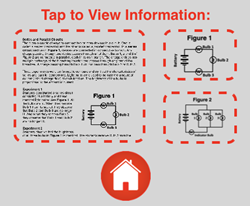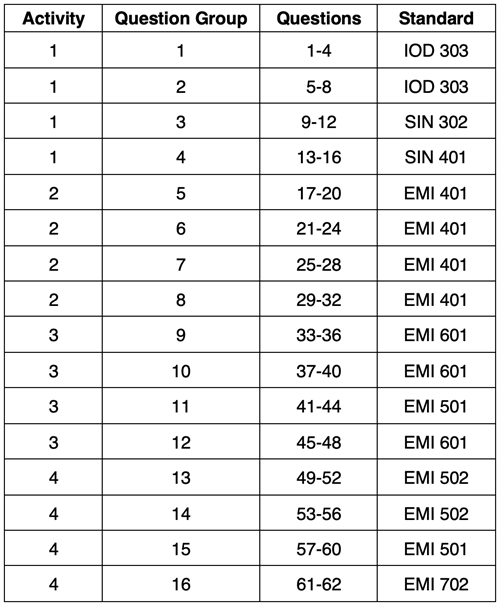About the Science Reasoning Center
 Highly Recommended
Highly RecommendedLike all our Science Reasoning Center activities, the completion of the Series and Parallel Circuits activity requires that a student use provided information about a phenomenon, experiment, or data presentation to answer questions. This information is accessible by tapping on the small thumbnails found on the bottom right of every question. However, it may be considerably easier to have a printed copy of this information or to display the information in a separate browser window. You can access this information from this page.
The Standards
The Series and Parallel Circuits activity describes three simple experiments in which the characteristics of series and parallel circuits are compared and contrasted. Figures and written descriptions of observations are provided to describe how the arrangement of light bulbs affects the bulb brightness. Questions target a student's ability to understand an experimental design, to draw conclusions that are consistent with provided data, to make appropriate inferences based on observations, to identify simple relationships between variables, and to identify the experimental conditions that would lead to specific results.
Success with the activity requires some degree of proficiency with respect to ...
- Asking Questions and Defining Problems (Science and Engineering Practice 1.2)
Ask questions that arise from examining models or a theory, to clarify and/or seek additional information and relationships. - Developing and Using Models (Science and Engineering Practice 2.1)
Evaluate merits and limitations of two different models of the same proposed tool, process, mechanism, or system in order to select or revise a model that best fits the evidence or design criteria. - Developing and Using Models (Science and Engineering Practice 2.3)
Develop, revise, and/or use a model based on evidence to illustrate and/or predict the relationships between systems or between components of a system. - Planning and Carrying Out Investigations (Science and Engineering Practice 3.5)
Make directional hypotheses that specify what happens to a dependent variable when an independent variable is manipulated. - Analyzing and Interpreting Data (Science and Engineering Practice 4.1)
Analyze data using tools, technologies, and/or models (e.g., computational, mathematical) in order to make valid and reliable scientific claims or determine an optimal design solution. - Engaging in Argument from Evidence (Science and Engineering Practice 7.4)
Construct, use, and/or present an oral and written argument or counter-arguments based on data and evidence. - Patterns (Crosscutting Concept 1.2)
Empirical evidence is needed to identify patterns.
While the Series and Parallel Circuits activity addresses the six NextGen Science and Engineering Practices and the crosscutting concept above, the activity drew its greatest inspiration from ACT's College Readiness Standards for Science Reasoning. The activity consists of 62 questions organized into 16 Question Groups that are spread across the four activities. All three strands (Interpretation of Data - IOD; Science Investigation - SIN; and Evaluation of Models, Inferences, and Experimental Results - EMI) of the College Readiness Standards are addressed in this activity. The code given for the standard includes three letters to indicate the strand and three numbers to indicate the specific standard within that strand. Higher numbers are indicative of more complex science reasoning skills. The relationship between the questions and the standards is as follows:

Complementary and Similar Resources
The following resources at The Physics Classroom website complement the Series and Parallel Circuits Science Reasoning Activity. Teachers may find them useful for supporting students and/or as components of lesson plans and unit plans.
Physics Classroom Tutorial, Electric Circuits Chapter: Series Circuits
Physics Classroom Tutorial, Electric Circuits Chapter: Parallel Circuits
Physics Video Tutorial, Electric Circuits: Series Circuit Relationships
Physics Video Tutorial, Electric Circuits: Parallel Circuit Relationships
Physics Interactives, Electric Circuits: DC Circuit Builder Simulation
Concept Builders, Electric Circuits: Series vs. Parallel Circuits
Minds On Physics, Electric Circuits Module, Mission EC7: Series Circuit Concepts
Minds On Physics, Electric Circuits Module, Mission EC8: Parallel Circuit Concepts
The Calculator Pad, Electric Circuits, Problem Sets EC9 - EC14
Recommended: Print Passage, Tables, and Graphs
Also see: